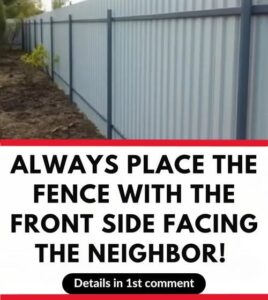Why You Should Always Face the “Good Side” of Your Fence Toward Your Neighbor

When building or replacing a fence, most homeowners focus on the practical reasons — privacy, security, and property boundaries. But there’s one small detail that’s often overlooked and can make a big difference: the finished, more attractive side of your fence should always face your neighbor’s property.
It might sound like a minor design choice, but this simple act of courtesy has meaningful effects — not just for neighborhood harmony, but for legal compliance and the overall look of your home.
1. It Shows Respect and Builds Goodwill
Placing the “good side” of the fence toward your neighbor is widely recognized as a gesture of respect and friendliness. It communicates that you care about how your shared boundary looks from their side — and that you value maintaining a positive relationship.
Fences can sometimes create tension between neighbors, especially if there’s a misunderstanding about property lines or appearance. By ensuring the finished side faces outward, you help avoid potential disputes before they start. It’s a small courtesy that can go a long way in preserving peace and cooperation next door.
2. It’s Often a Legal Requirement
Beyond politeness, this fence rule can also be a matter of local regulation. In many areas, building codes and homeowners’ association (HOA) guidelines specifically state that the “finished” or “smooth” side of a fence must face outward toward neighboring properties or public streets.
Failing to follow these standards could result in a citation, fines, or even a demand to rebuild the fence — all of which can be costly and time-consuming. Before beginning any fencing project, it’s wise to review your local ordinances and confirm your property boundaries to stay compliant and avoid unnecessary conflict.
3. It Enhances Your Home’s Curb Appeal
The direction your fence faces can also influence how your home looks from the outside. If the structural posts, rails, or unfinished sides of the fence face outward, the result can appear rough or incomplete — not exactly the impression you want to make.
Facing the polished, decorative side toward your neighbor (and the street) keeps your property looking clean, intentional, and well-kept. A good-looking fence not only improves your home’s curb appeal but can even boost resale value, as first impressions play a big role in real estate.
4. It Reflects Common Courtesy and Good Design
Fencing etiquette is a long-standing tradition that promotes fairness and mutual respect among property owners. While it may be tempting to want the attractive side facing inward, the universally accepted standard is to present the neat, finished side to the outside world.
If you prefer both sides to look equally nice, consider investing in a double-sided fence (also known as a “good neighbor fence”), which features finished panels on both sides. These designs look symmetrical and balanced — a win-win for everyone.
5. Tips for a Smooth Fence Project
To ensure your fence installation goes as smoothly as possible:
-
Check local codes and HOA rules before you begin.
-
Discuss plans with your neighbors in advance — clear communication helps prevent misunderstandings.
-
Choose a design that complements both properties.
-
Maintain the fence regularly, regardless of which way it faces — because a neglected fence can sour relationships just as quickly as a poorly placed one.
Final Thoughts
While it might seem like a small detail, the direction your fence faces speaks volumes about your approach to neighborly respect and responsible homeownership. Facing the good side outward isn’t just about aesthetics — it’s about thoughtfulness, cooperation, and maintaining harmony within your community.
In the end, a fence isn’t just a divider — it’s a shared boundary. When built with care and respect, it can help bring neighbors closer together, not push them apart.